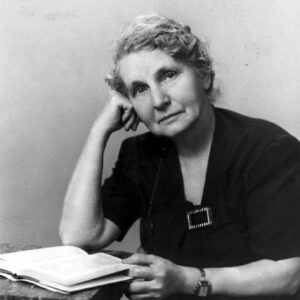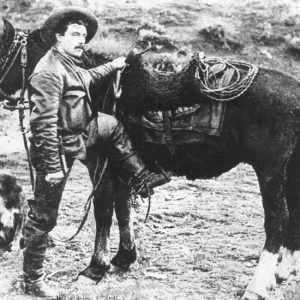calsfoundation@cals.org
Arkansas: A Guide to the State
Arkansas: A Guide to the State was a book project of the Federal Writers’ Project of the Works Progress Administration (WPA), a Depression-era federal relief program, that provided information about Arkansas, its people, and its culture, along with a variety of tour routes that explored every area of the state. It was first published in 1941.
The Federal Writers’ Project (FWP) was created in 1935 as part of the WPA to provide work for unemployed writers and editors during the Great Depression. One of the best-known products of the FWP was a series of guidebooks to the various states in the Union. Work on the Arkansas edition began initially under the leadership of Bernie Babcock and Charles J. Finger, but in late 1938, state WPA administrator Floyd Sharp appointed Dallas McKown to lead the project. McKown, who had lived in Fort Smith (Sebastian County) as a boy, was a graduate of the University of Colorado who had experience in the publishing industry. He brought in Jean Winkler, Walter E. Rowland, Faye Webber, and Richard F. McCue to serve on the editorial staff to complete the project, which was sponsored by Secretary of State C. G. “Crip” Hall.
As the content for the Guide was being compiled, McKown sent a portion of it to WPA headquarters in Washington DC for publication—a twenty-eight-page guide featuring eleven tour routes in the state. McKown announced that “the Arkansas booklet will be part of a vacation guide which will be distributed to automobile clubs and hotels throughout the nation.”
The first section of Arkansas: A Guide to the State consists of series of nineteen essays that cover Arkansas’s natural resources, archeology, prehistory and history, government, agriculture and industry, religion, folklore, arts, and other subjects. One reviewer praised “the essays which make up the first part of the Guide, possibly the finest part.”
The book’s second section focuses on Arkansas’s largest cities and towns, with details on Blytheville (Mississippi County), El Dorado (Union County), Fort Smith, Hot Springs (Garland County), Jonesboro (Craighead County), Little Rock (Pulaski County), Pine Bluff (Jefferson County), and Texarkana (Miller County).
The Guide’s third section features seventeen tour routes exploring every section of the state. An Arkansas Gazette reviewer stated that the tours “are no lackadaisical logs of motorists skimming along the highway at 50 miles an hour and jotting down sights visible only from the pavement. They are also the products of observant researchers intensely curious about everything in, around and near every town, hamlet and jog in the road.”
The final section includes an extensive bibliography and a list of 147 people who served as consultants for the project, which included notable Arkansans such as artists Adrian Brewer and H. Louis Freund, attorney Scipio A. Jones, pioneering archeologists Sam Dellinger and S. Dorris Dickinson, newspaper editor Tom Shiras, home demonstration agent Connie Bonslagel, college president John Brown Watson, architects Lawson Delony and Howard Eichenbaum, and historians Clara B. Eno and Dallas T. Herndon. It was “profusely, even handsomely illustrated with 108 photographs.”
Arkansas: A Guide to the State was published by New York’s Hastings House in August 1941 and was met with positive reviews. An Arkansas Gazette writer wrote that “if you read the 447 pages of this volume, or even browse through them, you are likely to put the book down with a feeling of chagrin that may give way to wonder and even pride.” An Associated Press reviewer held that Arkansas’s “extraordinary variety is set down in the new Guide—its truly lovely mountains, its wide cotton fields, its show boats and its curative springs.”
The Guide was updated in 1947 and reissued in 1973 by the Scholarly Press of St. Claire Shores, Michigan, but in 1987, the University Press of Kansas published it as The WPA Guide to 1930s Arkansas, with an introduction by University of Arkansas (UA) historian Elliott West that updated many of the economic and demographic changes that had occurred in the state since 1941. One reviewer of the new edition wrote that “the old WPA guidebook is a necessary part of anyone’s Arkansas collection, and the new cover makes it much more attractive. If you are planning any Arkansas travelling, don’t leave home without it, but also don’t forget to take along the latest highway department map.” An Arkansas Times writer noted that “much of the information is out of date, but a surprising amount is still useful, and even the antiquated stuff illuminates how the state’s best minds viewed things fifty years ago.”
For additional information:
“Arkansas Guide Book Revised Second Time.” Arkansas Gazette, August 16, 1947, p. 8.
Blackman, M. C. “Arkansas: A Guide to the State Wins Praise of Reviewer.” Arkansas Gazette, August 31, 1941, p. 25.
“Data for Tourists.” Arkansas Gazette, November 27, 1938, p. 3.
Federal Writers’ Project. Arkansas: A Guide to the State. New York: Hastings House, 1941.
Holley, Donald. “The WPA Guide to 1930s Arkansas.” Arkansas Historical Quarterly 47 (Autumn 1988): 290–291.
Lancaster, Bob. “A Classic Guidebook Returns and It’s Still A Pleasure To Read.” Arkansas Times, February 1988, p. 22.
Lynn, Charles R. “News about People.” Arkansas Gazette, August 31, 1941, p. 5.
Mitchell, Mason E. “Review of Arkansas: A Guide to the State.” Arkansas Historical Quarterly 1 (June 1942): 163–165.
Schnedler, Jack. “So Near and Yet So Far: 1941’s WPA Guide to Arkansas a Snippet of Time.” Arkansas Democrat-Gazette, November 22, 2021, pp. 1D, 6D. Online at https://www.arkansasonline.com/news/2021/nov/22/so-near-and-yet-so-far/ (accessed November 22, 2021).
“Variations on a Theme.” Arkansas Gazette Sunday Magazine, September 21, 1941, p. 4.
“Will Head Writers Project.” Arkansas Gazette, November 27, 1938, p. 3.
The WPA Guide to 1930s Arkansas. Lawrence: University Press of Kansas, 1987.
Mark K. Christ
Central Arkansas Library System








Comments
No comments on this entry yet.